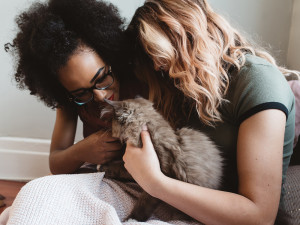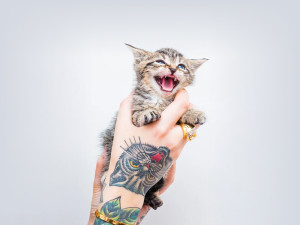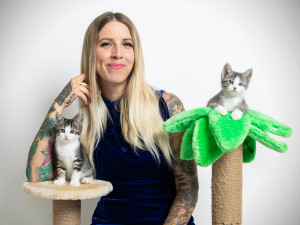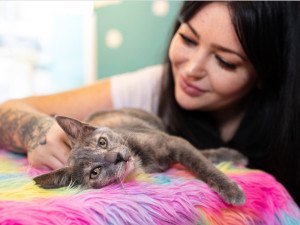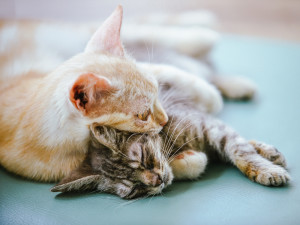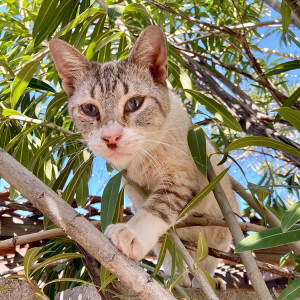How to Tell if a Cat Is Pregnant
Are kittens on the way? Here’s how to find out.
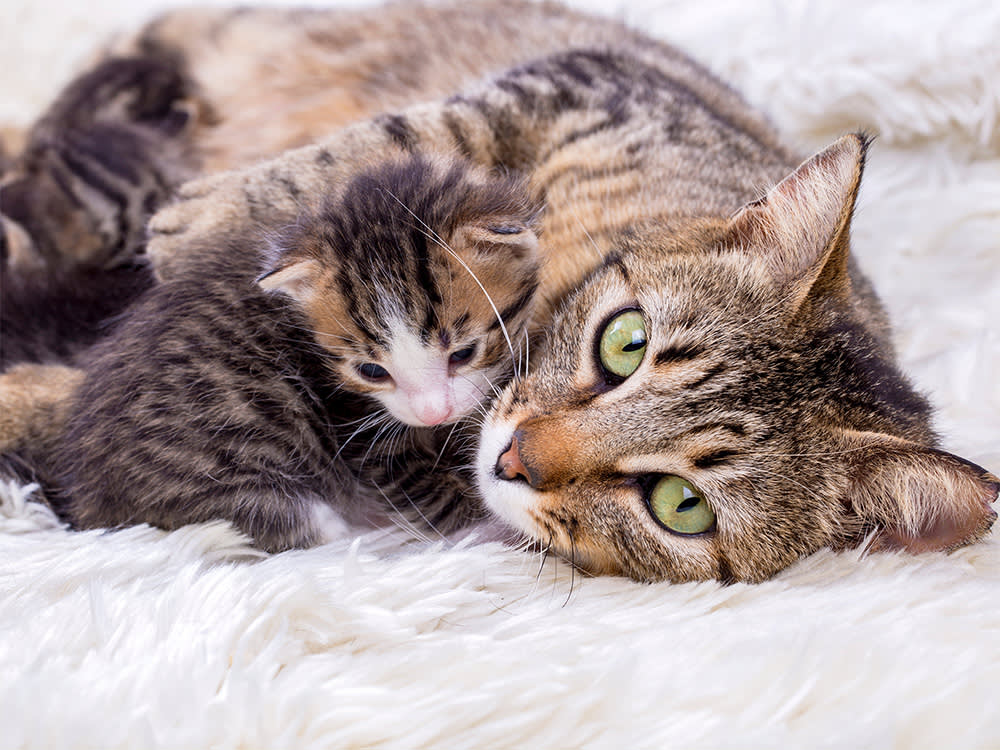
share article

Your pet wants you to read our newsletter. (Then give them a treat.)
Here’s a question: Are you about to have a bunch of tiny new family members running around the house in the form of fuzzy kittens? There are some key things to look for if you’re wondering if your cat is pregnant.
A pregnant cat will gain weightopens in a new tab steadily throughout her pregnancy. Her nipples will also become rosy pink and more prominent. She may also become more affectionate or withdrawn or start nesting. The best way to confirm pregnancy is to take your cat to the vet for a physical exam and imaging. With proper care, your pregnant cat should have a healthy and uneventful pregnancy.
Signs of pregnancy in cats
Many cat pregnancies are a surprise to their parents. Pregnancy is possible in any intact female cat who has recently been adopted from a shelter or rescue, outside of the house, or around an unneutered male cat (even for a short time). It can be difficult to tell if your cat is pregnant at home, but there are some signs of pregnancy in cats that may tip you off.
What are the physical symptoms of pregnancy in cats?
Pregnancy signs in cats are often vague early on. Despite steady weight gain, many cats look the same as usual up to halfway through their pregnancy. Subtle symptoms can include decreased appetite, nausea, or vomitingopens in a new tab. This is inconsistent though, because some cats will show an increase in appetite due torising energy requirementsopens in a new tab as the fetuses develop.
The amount of weight gained varies from cat to cat, and some cats can put on over 50 percentopens in a new tab of their baseline body weight during pregnancy. It can be difficult to tell if all that weight gain is due to the growing fetuses or if your cat is developing obesity as well. Tracking your cat’s weight and body condition with your veterinarian can help you to help before unexpected problems develop. Obese cats have anincreased riskopens in a new tab of stillbirths and difficult laboropens in a new tab.
Other physical symptoms of pregnancy in cats include:
Prominent nipples: A cat’s normally near-invisible nipples will become more prominent and elongate to give nursing kittens a better hold.
Mammary gland enlargement: Cats tend to not lactate prior to birthing kittens, but some mammary gland enlargement may be noted very late in the pregnancy.
Round belly: In the second half of the pregnancy, progressive enlargement of a cat’s abdomen will become more evident. This may not be as obvious in cats with obesity or long coats.
What are the behavioral symptoms of pregnancy in cats?
A change in cat behavior during pregnancy is expected. Most cats become more affectionate early in the pregnancy, though some can become standoffish. Decreased friendliness may be more common in cats who are experiencing nausea in the first few weeks of pregnancy. Nesting behavior is also common in pregnant cats, especially as their due date approaches.
Nesting behavior can take many forms. Some outdoor cats may begin to prefer staying in or near the house rather than roaming. Indoor cats can be seen poking around the house to find a warm, clean, quiet area where they feel safe. Setting up a nesting box for your pregnant kitty can be helpful, but she may choose to set up shop in an entirely different area. Cats are just like that, try not to be too offended.
Can I confirm my cat is pregnant at home?
If you’ve noticed behavior changes and an expanding waistline, you may wonder how to tell if your female cat is pregnant at home. Until you actually see kittens coming out, it can be hard to confirm that your cat is pregnant at home with any certainty.
A few weeks into her pregnancy, your cat will develop enlarged segments of her uterus that will expand over time. It is not recommended to feel for this at home for a few reasons:
Finding the uterus is difficult in large or obese cats, cats with a full bladder, and cats who resent having their bellies touched.
If you’re not trained to palpate a cat’s abdomen, it’s difficult to differentiate a poop-filled colon, bladder, or kidneys from an enlarged uterus.
Squeezing on the uterus too hard can cause damage to it or the fetuses.
The best solution is to get your cat checked out by a veterinarian if you think she may be pregnant. They’ll want to know some basic information about your cat’s behavior, normal appearance, possible exposure to male cats, and last heat cycle.
How do vets confirm pregnancy in cats?
Veterinarians can tell if a cat is pregnant using one of three methods. Each method has its pros and cons, so your vet may recommend different tests depending on the time since your cat’s last heat or breeding. A pregnancy check always starts with a physical examination to make sure there are no other obvious health issues.
Radiographs (x-rays) can detect changes in the uterus starting 17 to 21 days after breeding. Despite the potential for early recognition, radiographs are not recommended until 40 days after breeding to limit radiation exposure early in development. Even if pregnancy is confirmed earlier, taking radiographs after 40 days may be recommended to count the number of fetuses present.
Blood tests can show hormone changes associated with fetal and placental development. There are tests available for relaxin, which is a hormone produced by the placenta. This blood test has the most accurate results if it’s done four weeks after your cat mates.
Ultrasonography requires a skilled operator and quality equipment to accurately diagnose pregnancy early in gestation. Changes to the uterus can be seen within a week of breeding, and evidence of fetal blood flow may be apparent in as little as 15 days. Ultrasonography isn’t perfect because evidence of pregnancy can be missed if the uterus is hidden behind or confused with intestines.
How long is a cat’s gestation period?
Cat pregnancy length does not vary much. Over 95 percent of births occur within61 to 70 daysopens in a new tab of breeding. The usual time that is quoted is 65 days, plus or minus one day. If the date of breeding is not known, testing may be able to help determine approximately how far along your cat is.
How do I know what stage of pregnancy my cat is in?
The stages of pregnancy are not as well-defined in cats as they are in humans. This doesn’t mean that your veterinarian can’t tell about how long your cat has been pregnant, though. There are a few different landmarks that can give a good idea of how long the fetuses have been developing and when they should make an appearance.
Hormone levels can give an idea of how far along your cat is, but they require repeat testing to determine which hormones are increasing, when they plateau, and when they start to decrease. Ultrasound is the best way to determine the age of a fetus. Some common ultrasound landmarks include:
Enlargement of the uterus (Day four)
Visible gestational chambers in the uterus (Day 10)
Fetal heart activity (Days 16 to 17)
Distinguishable fetus (Day 26)
Fetal movement (Day 28)
Defined fetal heart chambers (Day 50)
Combining these findings with measurements of the size of the gestational sac (early in pregnancy) or diameter of the fetal skull (late in pregnancy) can give a reasonably good idea of the expected date of birth.
What is the best way to care for a pregnant cat?
Pregnant cats don’t require too much extra care. Your veterinarian will use your cat’s medical history to know if she needs any additional medications. Veterinarians will commonly recommend good flea control and deworming to prevent anemia in the kittens and queen. Cats who are intentionally bred should be fully up to date on vaccinations prior to breeding, but vaccination is not recommended during pregnancy due to risks to the fetus.
Other ways to support your pregnant cat include:
Feed a high-quality diet. A “growth” diet is often recommended due to its higher nutrient density, which is useful during fetal development and lactation after birth.
Provide a quiet, comfortable place to nest. Cats will want to pick out a safe place to deliver before the time comes.
Avoid outdoor roaming. This could increase the risk of complications, such as parasites and viral diseases. Pregnant cats are also slower and may have trouble avoiding dangers.
Check in with your vetopens in a new tab regularly. Your veterinarian can monitor fetal development, watch out for health issues, and make sure your cat is maintaining an appropriate weight.
How do I know that my cat is ready to give birth?
Cats usually begin seeking a nesting area about a week before birth. This area will usually be away from people and other pets. You can set up some soft bedding and barriers to see if this helps.
A few hours to a couple of days before birth, your cat will begin to seem restless. This can involve increased vocalization, grooming, pacing, panting, or even vomiting. This will generally be done in or around the nesting area and is considered the first stage of labor. During this time, milder uterine contractions and cervical dilation are occurring.
Once this process has started, don’t try to move your cat to a different nesting area or start handling her more. Your cat has picked her spot and is going through the expected pre-birth routine. Interrupting this could throw her off and delay delivery.
What can I expect during the birthing process?
Birthing starts with the second stage of labor. During this time, the uterine contractions become stronger and are accompanied by abdominal pushing. Kittens are produced during this stage, usually 30 minutes to an hour apart. Cats can stop their labor for up to a day if they feel stressed or are interrupted. It’s best to leave them to their business and not get involved unless there is a problem. The third stage of labor often happens at the same time as the second. It involves the expulsion of the fetal membranes and placenta, which the queen may eat.
Strong contractions without production of a kitten within 60 minutes or vaginal bleeding are abnormal. If either of these is noted, intervene and take your cat to a veterinarian as soon as possible.
How many kittens can I expect my cat to have?
Most catshave littersopens in a new tab between one and five kittens in size. The average was 3.7 kittens per litter in a 1995 study. Kitten mortality rates arefairly highopens in a new tab, between 14 and 16 percent, so unfortunately it’s not uncommon to have a kitten pass away before the two-month mark. Watchful pet parents and good veterinary careopens in a new tab can help, though. Watch to make sure everyone is nursing and gaining weight, and act quickly if you feel a kitten is falling behind.
FAQs (People also ask):
Is it safe for my pregnant cat to continue her vaccinations and flea treatments?
It’s always best to follow your veterinarian’s advice for your specific cat. Flea treatments are usually continued during pregnancy, but vaccines are generally pushed back until after delivery to prevent complications.
What should I feed my pregnant cat?
Pregnant cats are often fed a “growth” diet intended for rapidly growing kittens. This may not be necessary for the whole pregnancy, but it becomes more important during the final weeks of rapid growth and during lactation.
When can I start noticing signs of pregnancy in my cat?
Signs like increased affection may be apparent in the first couple of weeks of pregnancy. A visibly enlarged abdomen is often not obvious until four to six weeks into the pregnancy.
References:
Energy and Protein Beeds of Cats for Maintenance, Gestation and Lactationopens in a new tab
Effect of the Nutrition Status onPparturition in the Catopens in a new tab
Feline Breeding and Pregnancy Management: What is Normal and When to Interveneopens in a new tab

Dr. Bartley Harrison, DVM
Dr. Bartley Harrison, DVM is a small animal veterinarian based in North Carolina who has practiced emergency medicine since graduating from the Texas A&M College of Veterinary Medicine. His primary interest areas include pain management, cardiology, and the treatment of shock.
He is a member of the Veterinary Emergency and Critical Care Society, American Veterinary Medical Association, and American Medical Writers Association. In addition to his clinical work, he writes pet health articles to help provide accurate information for both new and experienced pet parents. When he’s not working, he enjoys cooking, traveling, reading, and going on adventures with his dog.
Related articles
![The Wildest's cover star Hannah Shaw smiling at the camera behind a cat tower with two kittens sitting on top of it]() opens in a new tab
opens in a new tab“Kitten Lady” Hannah Shaw Is Fostering a Movement
The lion-hearted animal advocate on rescuing her first kitten in a tree, designing an orphaned animal nursery, and becoming an Instagram sensation.
![]() opens in a new tab
opens in a new tabA Rescue Kitten Cafe Opens in Venice...and It’s Called Tiny Beans
Adoptable kittens, nitro cold brew, and beach vibes? On my way...
![two bonded kittens snuggling]() opens in a new tab
opens in a new tabWhy You Should Adopt a “Less Adoptable” Cat
Here’s why bonded kitties, senior cats, and felines with FIV make just as amazing pets as any other.
![A cat peeking down from a tree.]() opens in a new tab
opens in a new tabMeet This Colony of Accidentally Insta-Famous Cats
How one cat colony inspired their hundreds of thousands of social media followers to care about cat rescue — and became superstars in the process.
![Woman using a laptop in bed, looking at her cat]() opens in a new tab
opens in a new tabWhat to Expect in the First 48 Hours With Your New Cat
Here’s how to help your rescue kitty feel at home.
